2. Link sharing
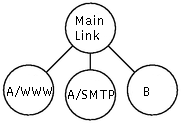 Problem: We have two customers, A
and B, both connected to the internet via eth0. We want to allocate 60 kbps to B
and 40 kbps to A. Next we want to subdivide A's bandwidth 30kbps for WWW and
10kbps for everything else. Any unused bandwidth can be used by any class which
needs it (in proportion of its allocated share).
Problem: We have two customers, A
and B, both connected to the internet via eth0. We want to allocate 60 kbps to B
and 40 kbps to A. Next we want to subdivide A's bandwidth 30kbps for WWW and
10kbps for everything else. Any unused bandwidth can be used by any class which
needs it (in proportion of its allocated share).
HTB ensures that the amount of service provided to each class is at least the minimum of the amount it requests and the amount assigned to it. When a class requests less than the amount assigned, the remaining (excess) bandwidth is distributed to other classes which request service.
Note: In the literature this is called "borrowing" the excess bandwidth. We use that term below to conform with the literature. We mention, however, that this seems like a bad term since there is no obligation to repay the resource that was "borrowed".
The different kinds of traffic above are represented by classes in HTB. The
simplest approach is shown in the picture at the right.
Let's see what
commands to use:
tc qdisc add dev eth0 root handle 1: htb default 12This command attaches queue discipline HTB to eth0 and gives it the "handle" 1:. This is just a name or identifier with which to refer to it below. The default 12 means that any traffic that is not otherwise classified will be assigned to class 1:12.
Note: In general (not just for HTB but for all qdiscs and classes in tc), handles are written x:y where x is an integer identifying a qdisc and y is an integer identifying a class belonging to that qdisc. The handle for a qdisc must have zero for its y value and the handle for a class must have a non-zero value for its y value. The "1:" above is treated as "1:0".
tc class add dev eth0 parent 1: classid 1:1 htb rate 100kbps ceil 100kbps burst 2k tc class add dev eth0 parent 1:1 classid 1:10 htb rate 30kbps ceil 100kbps burst 2k tc class add dev eth0 parent 1:1 classid 1:11 htb rate 10kbps ceil 100kbps burst 2k tc class add dev eth0 parent 1:1 classid 1:12 htb rate 60kbps ceil 100kbps burst 2k
The first line creates a "root" class, 1:1 under the qdisc 1:. The definition of a root class is one with the htb qdisc as its parent. A root class, like other classes under an htb qdisc allows its children to borrow from each other, but one root class cannot borrow from another. We could have created the other three classes directly under the htb qdisc, but then the excess bandwidth from one would not be available to the others. In this case we do want to allow borrowing, so we have to create an extra class to serve as the root and put the classes that will carry the real data under that. These are defined by the next three lines. The ceil and burst parameters are described below.
Note: Sometimes people ask me why they have to repeat dev eth0 when they have already used handle or parent. The reason is that handles are local to an interface, e.g., eth0 and eth1 could each have classes with handle 1:1.
We also have to describe which packets belong in which class. This is really not related to the HTB qdisc. See the tc filter documentation for details. The commands will look something like this:
tc filter add dev eth0 protocol ip parent 1:0 prio 1 u32 \ match ip src 1.2.3.4 match tcp dst 80 0xffff flowid 1:10 tc filter add dev eth0 protocol ip parent 1:0 prio 1 u32 \ match ip src 1.2.3.4 flowid 1:11(We identify A by its IP address which we imagine here to be 1.2.3.4.)
Note: The U32 classifier has an undocumented design bug which causes
duplicate entries to be listed by "tc filter show" when you use U32 classifiers
with different prio values. 
You may notice that we didn't create a filter for the 1:12 class. It might be more clear to do so, but this illustrates the use of the default. Any packet not classified by the two rules above (any packet not from source address 1.2.3.4) will be put in class 1:12.
Now we can optionally attach queuing disciplines to the leaf classes. If none is specified the default is pfifo.
tc qdisc add dev eth0 parent 1:10 handle 20: pfifo limit 5 tc qdisc add dev eth0 parent 1:11 handle 30: pfifo limit 5 tc qdisc add dev eth0 parent 1:12 handle 40: sfq perturb 10That's all the commands we need. Let's see what happens if we send packets of each class at 90kbps and then stop sending packets of one class at a time. Along the bottom of the graph are annotations like "0:90k". The horizontal position at the center of the label (in this case near the 9, also marked with a red "1") indicates the time at which the rate of some traffic class changes. Before the colon is an identifier for the class (0 for class 1:10, 1 for class 1:11, 2 for class 1:12) and after the colon is the new rate starting at the time where the annotation appears. For example, the rate of class 0 is changed to 90k at time 0, 0 (= 0k) at time 3, and back to 90k at time 6.
Initially all classes generate 90kb. Since this is higher than any of the rates specified, each class is limited to its specified rate. At time 3 when we stop sending class 0 packets, the rate allocated to class 0 is reallocated to the other two classes in proportion to their allocations, 1 part class 1 to 6 parts class 2. (The increase in class 1 is hard to see because it's only 4 kbps.) Similarly at time 9 when class 1 traffic stops its bandwidth is reallocated to the other two (and the increase in class 0 is similarly hard to see.) At time 15 it's easier to see that the allocation to class 2 is divided 3 parts for class 0 to 1 part for class 1. At time 18 both class 1 and class 2 stop so class 0 gets all 90 kbps it requests.
This might seem like a good solution if A and B were not different customers.
However, if A is paying for 40kbps then he would probably prefer his unused WWW
bandwidth to go to his own other service rather than to B. This requirement is
represented in HTB by the class hierarchy. Notes: Packet classification rules should assign only to leaf classes. (In
the current implementation, any packets assigned to interior classes are simply
dropped!). The rate supplied for a parent should be the sum of the rates of its
children. (We may later describe how it can be useful to violate this rule.)
The commands are now as follows: We now turn to the graph showing the results of the hierarchical solution.
When A's WWW traffic stops, its assigned bandwidth is reallocated to A's other
traffic so that A's total bandwidth is still the assigned 40kbps. The graph at right differs from the previous one at time 3 (when WWW traffic
stops) because A/other is limited to 20kbps. Therefore customer A gets only
20kbps in total and the unused 20kbps is allocated to B. This feature should be useful for ISPs because they probably want to limit
the amount of service a given customer gets even when other customers are not
requesting service. (ISPs probably want customers to pay more money for better
service.) Note that root classes are not allowed to borrow, so there's really no
point in specifying a ceil for them.
Notes: The ceil for a class should always be at least as high as the rate.
Also, the ceil for a class should always be at least as high as the ceil of any
of its children.
If cburst is smaller (ideally one packet size) it shapes bursts to not
exceed ceil rate in the same way as TBF's peakrate does.
When you set burst for parent class smaller than for some child then
you should expect the parent class to get stuck sometimes (because child will
drain more than parent can handle). HTB will remember these negative bursts up
to 2 minutes.
You can ask why I want bursts. Well it is cheap and simple way how to
improve response times on congested link. For example www traffic is bursty. You
ask for page, get it in burst and then read it. During that idle period burst
will "charge" again. Also see bellow at limitation when you really HAS to
use burst.
Note: The burst and cburst of a class should always be at least as high as
that of any of it children.
Limitation: when you operate with high rates on computer with low
resolution timer you need some minimal burst and cburst to be set
for all classes. Timer resolution on i386 systems is 10ms and 1ms on Alphas. If
you have fast Pentium I recommend you to redefine HZ from 100 to 1024 and
recompile kernel. Also set PSCHED_CLOCK_SOURCE to CPU. The minimal burst can be
computed as max_rate*timer_resolution. So that for 10Mbit on plain i386 you
needs burst 12kb.
If you set too small burst you will encounter smaller rate than you set. There is also second face of problem. It is total delay of packet. It is
relatively hard to measure on ethernet which is too fast (delay is so
neligible). But there is simple help. We can add simple HTB with one class rate
limiting to less then 100 kbps and add second HTB (the one we are measuring) as
child. Then we can simulate slower link with larger delays. Simulator is set to generate 50 kbps for both classes and at time 3s it
executes command: What class should you priorize ? Generaly those classes where you
really need low delays. The example could be video or audio traffic (and you
will really need to use correct rate here to prevent traffic to kill
other ones) or interactive (telnet, SSH) traffic which is bursty in nature and
will not negatively affect other flows. All active (having packets) leaves are linked to several circular lists one
for each priority. Pointers to most actual class in ring are in array
q->active[priority]. Recall level numbering from chapter 3. For resolution above we have to know limit status of class (both leaf and
interior) The mode can be HTB_CANT_SEND if class is over ceil, HTB_MAY_BORROW if
ofer rate but bellow ceil and HTB_CAN_SEND if bellow rate. Quantums in DRR are computed from rate dividing it by r2q
coeficient which can be set when creating discipline. It defaults to 10 and it
is good value for rates from 5 kbps to 500 kbps. For higher rates increase
r2q.
There is single DRR deficit per class in CBQ. HTB uses array of deficits
indexed by level at which we dequeue. From performance view the algorithm complexity is no_of_leaves *
tree_depth. It is very hard to evaluate cache hits but best performance for big
hierarchies is to have large number of leaves and smaller number of interior
classes (the lowest tree level is heavily branched). Older code: If you think that you found an error I will appreciate error report. For
oopses I need ksymoops output. For weird qdisc behaviour add parameter debug
3333333 to your tc qdisc add .... htb. It will log many megabytes to
syslog facility kern level debug. You will probably want to add line
like: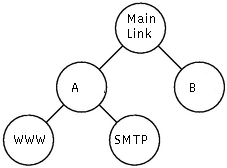
3. Sharing hierarchy
The problem from the previous chapter is solved by
the class hierarchy in this picture. Customer A is now explicitly represented by
its own class. Recall from above that the amount of service provided to each
class is at least the minimum of the amount it requests and the amount assigned
to it. This applies to htb classes that are not parents of other htb
classes. We call these leaf classes. For htb classes that are parents of other
htb classes, which we call interior classes, the rule is that the amount of
service is at least the minumum of the amount assigned to it and the sum of the
amount requested by its children. In this case we assign 40kbps to customer
A. That means that if A requests less than the allocated rate for WWW, the
excess will be used for A's other traffic (if there is demand for it), at least
until the sum is 40kbps.
tc class add dev eth0 parent 1: classid 1:1 htb rate 100kbps ceil 100kbps burst 2k
tc class add dev eth0 parent 1:1 classid 1:2 htb rate 40kbps ceil 100kbps burst 2k
tc class add dev eth0 parent 1:2 classid 1:10 htb rate 30kbps ceil 100kbps burst 2k
tc class add dev eth0 parent 1:2 classid 1:11 htb rate 10kbps ceil 100kbps burst 2k
tc class add dev eth0 parent 1:1 classid 1:12 htb rate 60kbps ceil 100kbps burst 2k
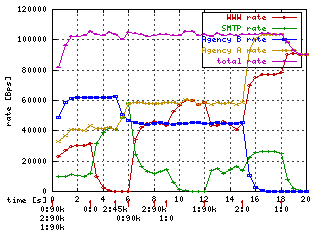
If A were
to request less than 40kbs in total then the excess would be given to B.
4. Rate ceiling
The ceil argument specifies the maximum bandwidth
that a class can use. This limits how much bandwidth that class can borrow. The
default ceil is the same as the rate. (That's why we had to specify it in the
examples above to show borrowing.) We now change the ceil 100kbps for
classes 1:2 (A) and 1:11 (A's other) from the previous chapter to ceil
60kbps and ceil 20kbps.
The second
difference is at time 15 when B stops. Without the ceil, all of its bandwidth
was given to A, but now A is only allowed to use 60kbps, so the remaining 40kbps
goes unused. 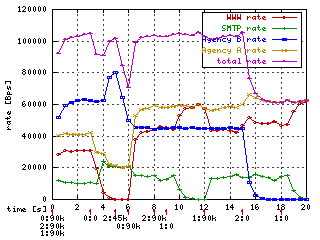
5. Burst
Networking hardware can only send one packet at a time and only
at a hardware dependent rate. Link sharing software can only use this ability to
approximate the effects of multiple links running at different (lower) speeds.
Therefore the rate and ceil are not really instantaneous measures but averages
over the time that it takes to send many packets. What really happens is that
the traffic from one class is sent a few packets at a time at the maximum speed
and then other classes are served for a while. The burst and
cburst parameters control the amount of data that can be sent at the
maximum (hardware) speed without trying to serve another class.
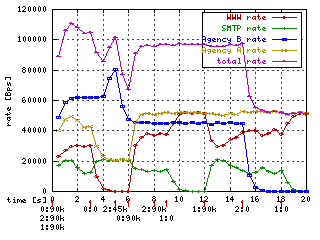 On graph you can see
case from previous chapter where I changed burst for red and yellow (agency A)
class to 20kb (from 2kb) but cburst remained 2 kb.
On graph you can see
case from previous chapter where I changed burst for red and yellow (agency A)
class to 20kb (from 2kb) but cburst remained 2 kb.
Green hill is at time 13
due to burst setting on SMTP class. A class. It has underlimit since time 9 and
accumulated 20 kb of burst. The hill is high up to 20 kbps (limited by ceil
because it has cburst near packet size).
Clever reader can think why there is
not red and yellow hill at time 7. It is because yellow is already at ceil limit
so it has no space for furtner bursts.
There is at least one unwanted
artifact - magenta crater at time 4. It is because I intentionaly "forgot" to
add burst to root link (1:1) class. It remembered hill from time 1 and when at
time 4 blue class wanted to borrow yellow's rate it denied it and compensated
itself.
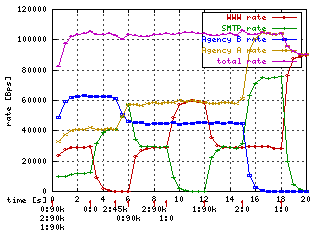
6. Priorizing bandwidth share
Priorizing traffic has two sides. First it
affects how the excess bandwidth is distributed among siblings. Up to now we
have seen that excess bandwidth was distibuted according to rate ratios. Now I
used basic configuration from chapter 3 (hierarchy without ceiling and bursts)
and changed priority of all classes to 1 except SMTP (green) which I set to 0
(higher).
From sharing view you see that the class got all the excess
bandwidth. The rule is that classes with higher priority are offered excess
bandwidth first. But rules about guaranted rate and ceil are
still met.
For simplicity
sake I use simple two class scenario: # qdisc for delay simulation
tc qdisc add dev eth0 root handle 100: htb
tc class add dev eth0 parent 100: classid 100:1 htb rate 90kbps burst 500
# real measured qdisc
tc qdisc add dev eth0 parent 100:1 handle 1: htb
AC="tc class add dev eth0 parent"
$AC 1: classid 1:1 htb rate 100kbps burst 2k
$AC 1:2 classid 1:10 htb rate 50kbps ceil 100kbps burst 2k prio 1
$AC 1:2 classid 1:11 htb rate 50kbps ceil 100kbps burst 2k prio 1
tc qdisc add dev eth0 parent 1:10 handle 20: pfifo limit 2
tc qdisc add dev eth0 parent 1:11 handle 21: pfifo limit 2
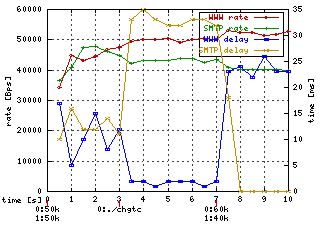 Note: HTB as
child of another HTB is NOT the same as class under another class within the
same HTB. It is because when class in HTB can send it will send as soon as
hardware equipment can. So that delay of underlimit class is limited only by
equipment and not by ancestors.
Note: HTB as
child of another HTB is NOT the same as class under another class within the
same HTB. It is because when class in HTB can send it will send as soon as
hardware equipment can. So that delay of underlimit class is limited only by
equipment and not by ancestors.
In HTB under HTB case the outer HTB simulates
new hardware equipment with all consequences (larger delay)
tc class change dev eth0 parent 1:2 classid 1:10 htb \
rate 50kbps ceil 100kbps burst 2k prio 0
As you see the delay of WWW class dropped nearly to the zero while SMTP's
delay increased. When you priorize to get better delay it always makes other
class delays worse.
Later (time 7s) the simulator starts to generate WWW at
60 kbps and SMTP at 40 kbps. There you can observe next interesting behaviour.
When class is overlimit (WWW) then HTB priorizes underlimit part of bandwidth
first.
Common trick is to priorize ICMP to
get nice ping delays even on fully utilized links (but from technical point of
view it is not what you want when measuring connectivity). 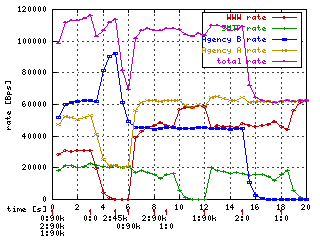
7. Injecting bandwidth
Levels
HTB explicitly allows you to have leaves on different levels.
Here B is a leaf while A is an interior class (on the same level). The maximal
tree depth is limited at compile time. (The default is 4.) Leaves always have
level 0. Each interior class has level MAX_DEPTH-1-D where D is its distance
from the root. The command tc -d class htb show shows levels. It is a bit
hacky feature and a bit experimental (its usage is experimental not
implementation). You can use keyword inject followed by number N when
setting the class up. When such class then try to borrow from ancestor N levels
up it will always succeed and the borrow will NOT be accounted to higher
classes. We say that the ancestor has been injected external bandwidth.
What
is it good for ? You can have router where top level class represents trunk and
lower level child represents one modem link. The modem link can be feeded by
both trunk data and data generated by router itself (squid for example). You
don't want the locally generated data be accounted to trunk class but to BE
accounted to modem link class.
You can do it by setting modem link class
child's inject to 1. As example see picture - it is our example from chapter 4
(ceiled hierarchy) where the green (SMTP) class was given inject
1.
You can see that total (magenta) is often over 100kbps (total ceil).
The increment is the injected bandwidth. It is limited by green classe's ceil
(20kbps) but not by the yellow ceil (60kbps). If I use inject 0 the green
ceil would be ignored too. With inject 2 only magenta ceil (100kbps)
would be ignored.
8. Dequeue cache
The performance of
HTB is very good. But when you want to serve over 100Mbit with complex hiearchy
on PII/800 you can run into performace problems.
Then you can use
dcache keyword when creating HTB qdisc. The HTB will then remember which
class was dequeued last and tries to dequeue it again after performin some fast
validity checks. It will stay on the same class as long as its DRR quantum is
big enough.
It can double or triple throughtput of your QoS router. Only side
efect is bigger burstiness of data going from single class.
9. Understanding statistics
The tc tool allows you to gather
statistics of queuing disciplines in Linux. Unfortunately statistic results are
not explained by authors so that you often can't use them. Here I try to help
you to understand HTB's stats.
First whole HTB stats. The snippet bellow is
taken during simulation from chapter 3. # tc -s -d qdisc show dev eth0
qdisc pfifo 22: limit 5p
Sent 0 bytes 0 pkts (dropped 0, overlimits 0)
qdisc pfifo 21: limit 5p
Sent 2891500 bytes 5783 pkts (dropped 820, overlimits 0)
qdisc pfifo 20: limit 5p
Sent 1760000 bytes 3520 pkts (dropped 3320, overlimits 0)
qdisc htb 1: r2q 10 default 1
deq_util 1/345 deq_rate 693 trials_per_deq 2
Sent 4651500 bytes 9303 pkts (dropped 4140, overlimits 34251)
First three disciplines are HTB's children. Let's ignore them as PFIFO
stats are self explanatory.
In HTB stats deq_rate means how many times
per second the HTB was queried for packet. And trials_per_deq tells you
how much tries per dequeue it took to either get packet or decide that there is
nothing to send (one try is approximately one DRR run). These are primarily for
developers.
deq_util tells you fraction of time the HTB was busy in
dequeue. The number is precise only is you compiled kernel with
PSCHED_CLOCK_SOURCE set to CPU. When it goes to 1/4 is tells you that kernel is
spending one quarter of its time in HTB dequeue and it is bad. You have to lower
packet rate or get faster CPU. This value can help you to estimate max packet
rate you can use on your system.
overlimits tells you how many times
the discipline delayed a packet. Other stats are sefl explanatory. Let's look at
class' stats: tc -s -d class show dev eth0
class htb 1:1 root prio 0 rate 800Kbit ceil 800Kbit burst 2Kb/8 mpu 0b
cburst 2Kb/8 mpu 0b quantum 10240 level 3
Sent 5914000 bytes 11828 pkts (dropped 0, overlimits 0)
rate 70196bps 141pps
lended: 6872 borrowed: 0 giants: 0 injected: 0
class htb 1:2 parent 1:1 prio 0 rate 320Kbit ceil 4000Kbit burst 2Kb/8 mpu 0b
cburst 2Kb/8 mpu 0b quantum 4096 level 2
Sent 5914000 bytes 11828 pkts (dropped 0, overlimits 0)
rate 70196bps 141pps
lended: 1017 borrowed: 6872 giants: 0 injected: 0
class htb 1:10 parent 1:2 leaf 20: prio 1 rate 224Kbit ceil 800Kbit burst 2Kb/8 mpu 0b
cburst 2Kb/8 mpu 0b quantum 2867 level 0
Sent 2269000 bytes 4538 pkts (dropped 4400, overlimits 36358)
rate 14635bps 29pps
lended: 2939 borrowed: 1599 giants: 0 injected: 0
I deleted 1:11 and 1:12 class to make output shorter. As you see there are
parameters we set. Also there are level and DRR quantum
informations.
overlimits shows how many times class was asked to send
packet but he can't due to rate/ceil constraints (currently counted for leaves
only).
rate, pps tells you actual (10 sec averaged) rate going thru
class. It is the same rate as used by gating.
lended is # of packets
donated by this class (from its rate) and borrowed are packets for
whose we borrowed from parent. Lends are always computed class-local while
borrows are transitive (when 1:10 borrows from 1:2 which in turn borrows from
1:1 both 1:10 and 1:2 borrow counters are incremented).
giants is
number of packets larger than mtu set in tc command. HTB will work with these
but rates will not be accurate at all. Add mtu to your tc (defaults to 1600
bytes).
injected is how many packets
were injected.
10. How does it work
You should read Sally Floyd's paper on link sharing
for in-depth discussion. Her formal-sharing is very similar to HTB.
This is
done when HTB is asked for packet:
Step 3a is often
repeated for leaves only with different max_level. HTB computes whether leaf can
send and (which level it can send from) during first class access (in one
dequeue) and caches the result in variables rc_victim (which class has
rate to let) and rc_level (best_level for this leaf). Validity of these
is guarded by version in rcache_sn.
By using these
caches the computation is very fast. In fact I measured that it is 2.5 times
faster than CBQ in the same configuration.
The reason is not simple to understand
but DRR principle assumes that all active classes can either send (and we
substract packet len from deficit) or we add quantum to deficit. Both CBQ and
HTB exclude overlimit class as it would be inactive thus it will lost part of
its DRR share. It leads to inadequate excess bandwidth sharing. Simplest way
(but not ideal) is to have deficits private to levels. It leads to adequate
sharing per level and nearly perfect global sharing. There are #defines in code
so that you can play with both ways. Old (CBQ) way shows that classes with
smaller rate gets yet smaller share part.
Now I implemented real multilevel DRR. No #defines here.
What increases
performance too is to have bigger bursts and quantums. Then there is better
probability that several packets will be served from the same leaf.
11. TODO
I don't plan to add more functionality here (there is no need).
I observed that there is too many dequeue events which don't return packet.
There is simply missing way in Linux QoS to inform parent discipline that we
can't dequeue packet and that we will be able to do it at time XY. Then I simply
could return NULL from dequeue for all requests going before time I slept for.
But I can't do it now because every dequeue event could be scheduled by my
non-work-conserving child. There is need to
solve this problem. What about to add HTB parameter which can turn on
optimization based on assumption that all children are work conserving ?
12. Sources
Current code:
diff against
2.2.17 and probably other 2.2.x
diff against
2.4.17 and probably other 2.4.x
diff against iproute2
rel 991023 and tc
binary
diff against
2.2.17 and probably other 2.2.x
diff against
2.4.14 and probably other 2.4.x
diff against iproute2 rel
991023
gzipped i386 tc
binary (glibc-2.1.2 or later)
C source of traffic
simulator
example
shell script to gnuplot results
example control program for
simulator
13. Making, debugging and sending error reports
You have to patch kernel
to make it work. Download kernel source and use patch -p1 -i
htb_2.X.X.diff to apply the patch. Then use make menuconfig;make
bzImage as before.
Also you will have to use patched tc tool. The
patch is also in list above or you can download precompiled binary above.
kern.debug -/var/log/debug
to your /etc/syslog.conf. Then
bzip and send me the log via email (up to 10MB after bzipping) along with
description of problem and its time.